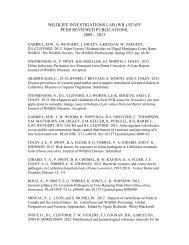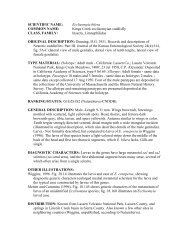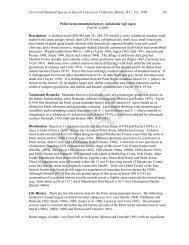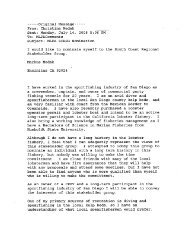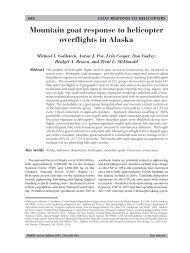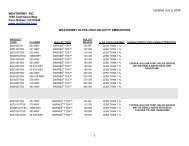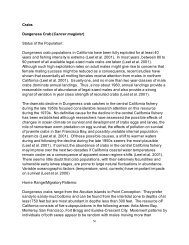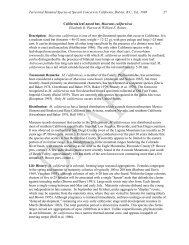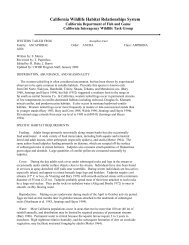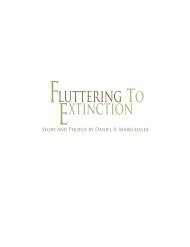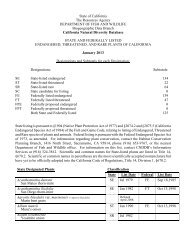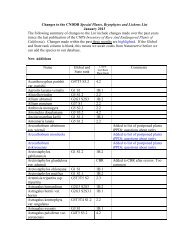ZONE X-7a and Area-Specific Archery Hunt A-13 - California ...
ZONE X-7a and Area-Specific Archery Hunt A-13 - California ...
ZONE X-7a and Area-Specific Archery Hunt A-13 - California ...
Create successful ePaper yourself
Turn your PDF publications into a flip-book with our unique Google optimized e-Paper software.
General Deer <strong>Hunt</strong>ing Information For<br />
<strong>ZONE</strong> X-<strong>7a</strong><br />
<strong>and</strong><br />
<strong>Area</strong>-<strong>Specific</strong> <strong>Archery</strong> <strong>Hunt</strong> A-<strong>13</strong><br />
(Includes Additional <strong>Hunt</strong> J-19)<br />
GENERAL INFORMATION FOR DEER HUNT <strong>ZONE</strong><br />
This information sheet has been prepared to assist deer hunters applying for, or planning to hunt in, Zone<br />
X-<strong>7a</strong> located in portions of Lassen, Nevada, Plumas <strong>and</strong> Sierra counties. The following information<br />
should be useful to hunters for archery season (A-<strong>13</strong>; Zone X-<strong>7a</strong> <strong>Archery</strong> <strong>Hunt</strong>), Zone X-<strong>7a</strong> general<br />
season <strong>and</strong> any “additional hunts” within this geographic area. For more specific information or additional<br />
questions regarding this area, contact the following Department office(s):<br />
North Central Region Office (Region 2), 1701 Nimbus Road, Rancho Cordova, CA 95670 (916-<br />
358-2900) encompassing Alpine, Amador, Butte, Calaveras, Colusa, El Dorado, Glenn, Lake,<br />
Nevada, Placer, Plumas, northeastern Sacramento, eastern San Joaquin, Sierra, Sutter, northern<br />
Yolo <strong>and</strong> Yuba counties.<br />
REGULATIONS<br />
Laws <strong>and</strong> regulations are designed to conserve wildlife <strong>and</strong> to provide for an equitable distribution of<br />
game mammals. The hunter who knows the laws <strong>and</strong> regulations can enjoy the hunting experience more.<br />
All hunters should read <strong>and</strong> be familiar with the current hunting regulations available online at:<br />
http://www.fgc.ca.gov/regulations/current/mammalregs.aspx<br />
Remember, if you are hunting on private property you must obtain, <strong>and</strong> have in your possession written<br />
permission to hunt on private property. <strong>Hunt</strong>er trespass laws are strictly enforced.<br />
Successful hunters are reminded to immediately fill out both portions of the tag <strong>and</strong> permanently mark the<br />
date of kill; attach the tag to the antlers, or ear if antlerless; have the tag validated <strong>and</strong> countersigned; <strong>and</strong><br />
return the completed report card portion to, or file an online harvest report (see highlighted area below on<br />
Internet Reporting) with DFG within 30 days of taking a deer.<br />
NEW for 2012 - Internet Reporting of Big Game Tags<br />
In anticipation of m<strong>and</strong>atory harvest reporting for all big game species in the future, in 2012 DFG will<br />
offer an Internet reporting option for hunters to submit big game tag/report card information. For the<br />
2012 hunting season, both successful <strong>and</strong> unsuccessful hunters will be able to report their hunt results<br />
online via DFG’s Online License Service at www.dfg.ca.gov/licensing/ols/ . <strong>Hunt</strong>ers logging on to the<br />
system will be able to view all their tags that require reports. <strong>Hunt</strong>ers submitting reports online will<br />
receive a report confirmation number <strong>and</strong> will not have to mail in their report card(s). DFG encourages<br />
all hunters (including those who were unsuccessful or who had a tag but did not hunt) to use this new<br />
service to meet their respective reporting requirement.<br />
Accurate harvest information is a crucial element in developing population estimates <strong>and</strong> resulting tag<br />
quotas, assessment of current hunt programs, <strong>and</strong> in the development of new opportunities. An online<br />
x<strong>7a</strong>zoneinfo2012 Page 1 of 5
eporting option will provide that information in a more timely <strong>and</strong> convenient manner. DFG anticipates<br />
that Internet reporting will be available beginning in July of 2012.<br />
OBTAINING DEER TAGS<br />
NEW for 2011 - Automated License Data System (ALDS)<br />
Beginning in late 2010, the Department began implementation of the new Automated License Data<br />
System (ALDS). Under this computer data system, all licenses, stamps <strong>and</strong> tags are applied for, <strong>and</strong><br />
issued through online Point-of-Sale terminals (IPOS) located at various Department license offices,<br />
over 1,400 license agents statewide or online at http://www.dfg.ca.gov/licensing/. Under ALDS much<br />
less paperwork is required to apply for, <strong>and</strong> receive tags. In addition, licenses, tags <strong>and</strong> entry into the<br />
Big Game Drawing can all be accomplished with one trip to a license agent. Once your personal<br />
information is entered <strong>and</strong> stored in the database, the database controls <strong>and</strong> tracks what you have<br />
applied for, or been issued, as well as preference points.<br />
Other than the way you apply for <strong>and</strong> receive licenses <strong>and</strong> tags, the primary difference you will notice is<br />
in the form that the license or tag comes. Instead of the old style license or postcard type deer tag, they<br />
will all come out of the IPOS terminal in the form of a long receipt. If successful at harvesting a deer,<br />
filling out the tag <strong>and</strong> report card portion, validation <strong>and</strong> report card return requirements remain<br />
unchanged. For more specific information on ALDS, application procedures <strong>and</strong> zone/hunt information,<br />
check out the 2012 <strong>California</strong> Big Game <strong>Hunt</strong>ing Digest available by May at most Department offices<br />
<strong>and</strong> license agents or online at: http://www.dfg.ca.gov/publications/digest/<br />
For deer tag distribution purposes, zones <strong>and</strong> hunts are classified based upon the date in which the zone<br />
or hunt tag quota is filled in the prior year. The three tag categories include:<br />
1) “Premium” zone/hunt tags are only issued through the Big Game Drawing using a First-Deer Tag<br />
Drawing Application, except that junior hunters may use their Second-Deer Tag Drawing Application<br />
to apply for Apprentice (J) <strong>Hunt</strong>s. <strong>Hunt</strong>ers will lose all accumulated deer preference points if drawn<br />
for their first choice in the Big Game Drawing.;<br />
2) “Restricted” zone/hunt tags are available upon application with a First-Deer Tag, or a Second-<br />
Deer Tag after August 1.; <strong>and</strong><br />
3) “Un-Restricted” zone/hunt tags are available at any time using either a First- or Second-Deer Tag.<br />
For Zone X-<strong>7a</strong> <strong>and</strong> associated hunts within the zone, the tag categories are as follows:<br />
1) Premium Deer <strong>Hunt</strong>s – X<strong>7a</strong>, A<strong>13</strong> <strong>and</strong> J19<br />
2) Restricted Deer <strong>Hunt</strong>s – None<br />
3) Un-Restricted Deer <strong>Hunt</strong>s – None<br />
General Season Tags (Zone X-<strong>7a</strong>): The 2012 deer hunting regulations specific to Zone X-<strong>7a</strong> <strong>and</strong> any<br />
additional hunts are listed at the end of this sheet. To hunt deer during the general season in Zone X-<strong>7a</strong>,<br />
a hunter must possess a Zone X-<strong>7a</strong> tag. This tag is valid in Zone X-<strong>7a</strong>, but ONLY during the prescribed<br />
general season. Zone X-<strong>7a</strong> tags MAY NOT be used to hunt deer during the <strong>Hunt</strong> A-<strong>13</strong> archery season,<br />
even with archery equipment.<br />
<strong>Archery</strong> Season Tags (<strong>Hunt</strong> A-<strong>13</strong>): To hunt deer during the archery season in Zone X-<strong>7a</strong>, hunters must<br />
possess an <strong>Area</strong>-<strong>Specific</strong> <strong>Archery</strong> <strong>Hunt</strong> A-<strong>13</strong> tag. This tag is only valid during the <strong>Hunt</strong> A-<strong>13</strong> archery<br />
season <strong>and</strong> MAY NOT be used to hunt deer during the general zone season, even with archery<br />
equipment. Additionally, <strong>Archery</strong> Only Tags (AO Tags) are NOT valid in any X zone or archery hunt within<br />
an X zone.<br />
Any additional deer hunts in Zone X-<strong>7a</strong> are listed in the Additional Deer <strong>Hunt</strong>s section near the end of this<br />
sheet. Typically, tags for additional deer hunts are in high dem<strong>and</strong> <strong>and</strong> distributed through the<br />
Department’s Big Game Drawing held in June. To receive tags for many of these hunts, hunters must<br />
plan ahead <strong>and</strong> apply by the June 2, 2012 deadline. Information regarding application procedures <strong>and</strong><br />
restrictions, ALDS, zone <strong>and</strong> hunt seasons, prior year drawing <strong>and</strong> hunt statistics are contained in the<br />
2012 Big Game <strong>Hunt</strong>ing Digest available at most Department offices, license agents <strong>and</strong> online at:<br />
http://www.dfg.ca.gov/publications/digest/<br />
x<strong>7a</strong>zoneinfo2012 Page 2 of 5
LAND OWNERSHIP/PUBLIC LAND OPPORTUNITIES<br />
Zone X-<strong>7a</strong> contains a mixture of both public <strong>and</strong> private l<strong>and</strong>s. Remember you must obtain <strong>and</strong> have in<br />
your possession written permission to hunt on private property. <strong>Hunt</strong>er trespass laws are strictly enforced.<br />
Public l<strong>and</strong>s within Zone X-<strong>7a</strong> are administered by the Humboldt-Toiyabe <strong>and</strong> Tahoe National Forests<br />
(USFS) <strong>and</strong> the Bureau of L<strong>and</strong> Management (BLM). For information regarding these l<strong>and</strong>s contact the<br />
following:<br />
USFS Offices:<br />
Humboldt-Toiyabe National Forest, 1200 Franklin Way, Sparks, NV 89431 (775-331-6444)<br />
Tahoe National Forest, 631 Coyote St., P.O. Box 6003, Nevada City CA 95959 (530-265-4531)<br />
BLM Offices:<br />
Carson City Field Office, 5665 Morgan Mill Road, Carson City, Nevada 89701 (775-885-6000)<br />
In Zone X-<strong>7a</strong> <strong>and</strong> other zones throughout <strong>California</strong>, additional deer hunting opportunities may exist on<br />
private property licensed through the Department’s Private L<strong>and</strong>s Management Program (PLM). For more<br />
information on the PLM <strong>and</strong> to obtain a list of participating ranches, go to the following link:<br />
http://www.dfg.ca.gov/wildlife/hunting/plm.html<br />
MAPS<br />
For general maps detailing individual zone or additional deer hunt boundaries, go to the following link:<br />
http://www.dfg.ca.gov/wildlife/hunting/deer/zonemapsinfo.html<br />
The most comprehensive map of the area is the Tahoe National Forest map. USFS maps are available<br />
locally at most USFS offices; by contacting the USFS Pacific Southwest Regional Office at: <strong>13</strong>23 Club<br />
Drive, Vallejo, CA 94592 (707-562-8737); or ordered by phone (406-329-3024), fax (406-329-3030), mail<br />
at USDA Forest Service, National Forest Store, P.O Box 8268, Missoula, MT 59807, or on-line at<br />
http://www.nationalforeststore.com/ .<br />
BLM surface management maps may also be useful. You can purchase these maps at BLM district<br />
offices or you can contact the BLM at 2800 Cottage Way, Suite W-1834, Sacramento, CA 95825 (916-<br />
978-4400).<br />
U.S. Geological Survey (USGS) topographic maps, are very helpful, especially for topographic features<br />
that are not displayed on USFS or BLM maps. USGS maps may be available from sporting goods,<br />
backpacking or engineering stores or you can contact the USGS directly at: Rocky Mountain Mapping<br />
Center, Branch of Information Services, Box 25286, Denver, CO 80225 (888-ASK-USGS).<br />
ACCESS/MAJOR ROADS<br />
Major access to Zone X-<strong>7a</strong> is provided by Highways 80 <strong>and</strong> 89. North of Highway 80 <strong>and</strong> west of<br />
Highway 89, private l<strong>and</strong>s are checker boarded throughout much of the Tahoe National Forest.<br />
WEATHER CONDITIONS/TRAVEL TIPS<br />
The weather in this region is highly variable so BE PREPARED. In most years, storms arrive during the<br />
deer season. Although storms are usually not serious, hunters should always be prepared for the event of<br />
a storm. Snow may fall at higher elevations but normally lasts only a short time. Roads usually dry out<br />
quickly. Most of the area is accessible with a two-wheel drive vehicle. Four-wheel drive may be required<br />
in some locations. Due to the complex road system in the Tahoe National Forest, horse packing <strong>and</strong><br />
backpacking are not necessary. However, if you choose to horse pack in, remember that it may be<br />
necessary to carry supplemental horse feed into the back country. Contact the local USFS <strong>and</strong>/or BLM<br />
office for more information regarding forage conditions for livestock. You should be prepared with<br />
appropriate clothing <strong>and</strong> equipment for a variety of weather conditions.<br />
Zone X-<strong>7a</strong> covers a large geographic area. The terrain can be very steep <strong>and</strong> rugged <strong>and</strong> vegetation can<br />
be extremely dense. As you should do in all remote areas, hunters are urged to bring a shovel, a good<br />
spare tire, extra water, etc. Use care when operating any vehicle off-road <strong>and</strong> check with the BLM or<br />
USFS for rules <strong>and</strong> regulations regarding vehicle <strong>and</strong> travel restrictions in the area.<br />
x<strong>7a</strong>zoneinfo2012 Page 3 of 5
CAMPING<br />
There are several USFS campgrounds within the Zone X-<strong>7a</strong> <strong>and</strong> these are shown on the map of the<br />
Tahoe National Forest. Informal camping is allowed on both USFS <strong>and</strong> BLM l<strong>and</strong>s, but campfire permits<br />
are required. Permits may be obtained from any USFS, BLM or <strong>California</strong> Department of Forestry (CDF)<br />
office. During fire season, special regulations may apply <strong>and</strong> it is best to contact the local USFS, BLM or<br />
CDF office for the latest information. Commercial lodging facilities are available in Truckee <strong>and</strong> Portola.<br />
Please, DO NOT camp or hunt for prolonged periods near water sources important to wildlife <strong>and</strong><br />
livestock. Remaining for over 30 minutes <strong>and</strong> within 200 yards of an artificial water source including<br />
guzzlers or horizontal wells on public l<strong>and</strong>s within <strong>California</strong> is a Fish <strong>and</strong> Game violation (Title 14,<br />
Section 730). You can pack water, wildlife can’t.<br />
HARVEST INFORMATION<br />
Information on deer harvest for this area is available in tables contained in the annual Deer Kill Reports<br />
available on-line at: http://www.dfg.ca.gov/wildlife/hunting/deer/deerhunt.html The most useful tables<br />
for the purposes of planning or applying for hunts in this area are Tables 1b (Harvest <strong>and</strong> Success<br />
Information), 2a (Antler Class Information) <strong>and</strong> 10b (Drawing Statistics).<br />
HERD CONDITIONS AND HABITATS<br />
The deer population in Zone X-<strong>7a</strong> is considered stable to declining, yet considerably below levels seen in<br />
the late 1960's <strong>and</strong> 1970's. As with most deer herds in <strong>California</strong> <strong>and</strong> other western states, the long-term<br />
population trend has been on a steady decline since the 1960’s <strong>and</strong> 1970’s. These long-term declines<br />
have been due to l<strong>and</strong> management practices that have precluded fire, resulting in changes toward more<br />
mature <strong>and</strong> less diverse habitats, <strong>and</strong> reduced quality <strong>and</strong> quantity of deer habitats. Short-term<br />
fluctuations in deer populations are usually attributed to weather events that affect forage production.<br />
The subspecies of deer inhabiting Zone X-<strong>7a</strong> is primarily the Rocky Mountain mule deer however you<br />
may encounter some Columbian black-tailed deer. Deer in Zone X-<strong>7a</strong> are considered migratory.<br />
However, hunter success has been better at lower elevations, since the drought in the late 1980's. Early<br />
storms may result in some deer movement, but deer generally do not migrate down towards winter<br />
ranges until serious storms with moderate to heavy snowfall hit later in the season.<br />
The vegetation is highly varied throughout Zone X-<strong>7a</strong> ranging from low sage, sagebrush, bitterbrush,<br />
aspen, hardwood-conifer, conifer <strong>and</strong> juniper to alpine habitats. Generally speaking, deer populations in<br />
this area respond favorably to vegetation disturbances that enhance brush species (wildfire <strong>and</strong> timber<br />
harvesting). Riparian areas (areas along watercourses), recently burned areas or clear cuts that have resprouted<br />
with brush are good areas to hunt. Typically, lower densities of deer are observed in the more<br />
densely forested areas or in older, more decadent brushl<strong>and</strong>s.<br />
HUNTING TIPS AND WHERE TO LOOK FOR DEER<br />
Successful hunters often spend a considerable amount of time scouting pre-season, locating individual or<br />
groups of deer, recently used deer trails, <strong>and</strong> feeding <strong>and</strong> bedding areas. You may not see many deer<br />
from the roads in this area <strong>and</strong> generally the more successful hunters do more hiking to locate deer.<br />
Binoculars <strong>and</strong>/or spotting scopes can be very helpful for locating <strong>and</strong> identifying deer at greater<br />
distances. In general, attempt to hunt areas that are away from other activities such as concentrations of<br />
hunters, vehicles, <strong>and</strong>/or livestock.<br />
Generally, the best hunting is near st<strong>and</strong>s of bitterbrush, mountain mahogany, or tall sagebrush, <strong>and</strong><br />
clear cuts that have re-sprouted with brush. The habitat varies from sagebrush flats at the lower<br />
elevations to mixed conifer forests to rimrock areas covered by mountain mahogany at the higher<br />
elevations. Historically, some of the more popular <strong>and</strong> productive areas in Zone X-<strong>7a</strong> include: Sardine<br />
Peak, Lemon Canyon, Dark Canyon, Lake of the Woods, Crystal Peak <strong>and</strong> Babbit Peak.<br />
For additional information about deer hunting in <strong>California</strong>, see the Department’s publication “Guide To<br />
<strong>Hunt</strong>ing Deer In <strong>California</strong>” at the following web site:<br />
http://www.dfg.ca.gov/wildlife/hunting/deer/docs/deerguide.pdf<br />
x<strong>7a</strong>zoneinfo2012 Page 4 of 5
ADDITIONAL DEER HUNTS<br />
In 2012, one additional hunt opportunity exists in Zone X-<strong>7a</strong>: 1) <strong>Hunt</strong> J-19 (Zone X-<strong>7a</strong> Apprentice Either-<br />
Sex Deer <strong>Hunt</strong>). For general maps detailing the individual hunt area boundaries, go to the following link:<br />
http://www.dfg.ca.gov/wildlife/hunting/deer/deermaps.html<br />
2012 <strong>ZONE</strong> AND ADDITIONAL HUNT SPECIFIC REGULATIONS<br />
(Any 2012 regulation changes from 2011 are highlighted in yellow.)<br />
§ 360. Deer.<br />
Except as otherwise provided in this Title 14, deer may be taken only as follows:<br />
(b) X-Zone <strong>Hunt</strong>s.<br />
(10) Zone X-<strong>7a</strong>.<br />
(A) <strong>Area</strong>: In those portions of Lassen, Nevada, Plumas <strong>and</strong> Sierra counties lying within a line beginning at the junction of<br />
Highway 395 <strong>and</strong> the <strong>California</strong>-Nevada state line at Bordertown; south along the Long Valley Road (County Road S570) to its<br />
intersection with the Henness Pass Road (County Road S860); west on Henness Pass Road over Summit 2 to the intersection<br />
with County Road S450 (near Davies Creek at Stampede Reservoir); west on County Road S450 (the Henness Pass Road)<br />
through Kyburz Flat to its intersection with Highway 89; south on Highway 89 to its intersection with Interstate 80 at Truckee;<br />
west on Interstate 80 to the Pacific Crest Trail near the Castle Peak-Boreal Ridge Summit; north on the Pacific Crest Trail to<br />
the new road to White Rock Lake (one mile west of White Rock Lake in section 21, T18N, R14E, M.D.B.M.); north on the new<br />
White Rock Lake Road below Bear Valley to the White Rock Lake Road; north on the White Rock Lake Road to the Jackson<br />
Meadows Highway (Fiberboard Road); east two miles on the Jackson Meadows Highway to the Yuba Pass Road at Webber<br />
Lake; north on the Yuba Pass Road (main haul road) through Bonta Saddle to Highway 49 at Yuba Pass; west on Highway 49<br />
to the new Gold Lake Road at Bassetts; north on the new Gold Lake Road to Highway 89 near Graeagle; north on Highway 89<br />
to Highway 70; east on Highway 70 to Highway 395 at Hallelujah Junction; south on Highway 395 to the point of beginning.<br />
(B) Season: The season in Zone X-<strong>7a</strong> shall open on the first Saturday in October <strong>and</strong> extend for 16 consecutive days.<br />
(C) Bag <strong>and</strong> Possession Limit: One buck, forked horn (See subsection 351(a)) or better, per tag.<br />
(D) Number of Tags: 230.<br />
(c) Additional <strong>Hunt</strong>s.<br />
(41) J-19 (Zone X-<strong>7a</strong> Apprentice Either-Sex Deer <strong>Hunt</strong>).<br />
(A) <strong>Area</strong>: In those portions of Lassen, Nevada, Plumas <strong>and</strong> Sierra Counties within the area described as zone X-<strong>7a</strong> (see<br />
subsection 360(b)(10)(A)).<br />
(B) Season: The season for additional hunt J-19 (Zone X-<strong>7a</strong> Apprentice Either-Sex Deer <strong>Hunt</strong>) shall be concurrent with the<br />
zone X-<strong>7a</strong> general season as defined in subsection 360(b)(10)(B).<br />
(C) Bag <strong>and</strong> Possession Limit: One either-sex deer (see subsection 351(c)) per tag.<br />
(D) Number of Tags: 25.<br />
(E) Special Conditions:<br />
1. Only junior license holders shall apply (see subsection 708.2).<br />
2. Tagholders shall be accompanied by an adult chaperon 18 years of age or older while hunting.<br />
(44) Conditions for Special <strong>Hunt</strong>s.<br />
(A) When hunting on military reservations or private l<strong>and</strong>s, hunters shall have in their possession a written permit signed by the<br />
l<strong>and</strong>owner, which may specify where <strong>and</strong> when the permittee may hunt.<br />
(B) When required, tagholders shall check in <strong>and</strong> check out of designated check stations.<br />
§ 361. <strong>Archery</strong> Deer <strong>Hunt</strong>ing.<br />
(b) <strong>Archery</strong> <strong>Hunt</strong>ing With <strong>Area</strong>-specific <strong>Archery</strong> Tags. Deer may be taken only with archery equipment specified in Section 354, only<br />
during the archery seasons as follows:<br />
(11) A-<strong>13</strong> (Zone X-<strong>7a</strong> <strong>Archery</strong> <strong>Hunt</strong>).<br />
(A) <strong>Area</strong>: As described in subsection 360(b)(10)(A).<br />
(B) Season: The archery season for hunt A-<strong>13</strong> (Zone X-<strong>7a</strong> <strong>Archery</strong> <strong>Hunt</strong>) shall open on the third Saturday in August <strong>and</strong><br />
extend for 23 consecutive days.<br />
(C) Bag <strong>and</strong> Possession Limit: One buck, forked horn (see subsection 351(a)) or better per tag.<br />
(D) Number of Tags: 50.<br />
(c) <strong>Archery</strong> <strong>Hunt</strong>ing with <strong>Archery</strong> Only Tags. Deer may be taken only with archery equipment specified in Section 354, during the<br />
archery seasons <strong>and</strong> general seasons as follows:<br />
(1) Number of <strong>Archery</strong> Only Tags Permitted. A person may obtain an archery only tag using a one-deer tag application <strong>and</strong> a<br />
second archery only tag using a second deer tag application.<br />
(2) Zones in Which <strong>Archery</strong> Only Tags are Valid. An archery only tag is valid for hunt G-10, <strong>and</strong> during the archery season <strong>and</strong><br />
general season in all zones except C-1 through C-4 <strong>and</strong> X-1 through X-12.<br />
(3) <strong>Area</strong>s: As described in subsections 360(a) <strong>and</strong> (c).<br />
(4) Seasons: The archery season <strong>and</strong> general seasons are provided in subsection 361(a) above <strong>and</strong> in subsections 360(a) <strong>and</strong><br />
(c).<br />
(5) Bag <strong>and</strong> Possession Limit: All bag <strong>and</strong> possession limits per zone are the same as those described in subsections 360(a)<br />
<strong>and</strong> (c).<br />
(d) <strong>Hunt</strong>ing <strong>Area</strong> Limitations. Archers not in possession of an archery only tag may hunt only in the zone, zones, or areas for<br />
which they have a general tag or an area-specific archery tag. (Refer to subsection 361(c)(2) for zones in which archery only<br />
tags are valid).<br />
(e) Crossbow Prohibition. Except as provided in subsection 354(j), crossbows may not be used during any archery season or<br />
during the general season when using an archery only tag.<br />
**** GOOD LUCK! ****<br />
x<strong>7a</strong>zoneinfo2012 Page 5 of 5



